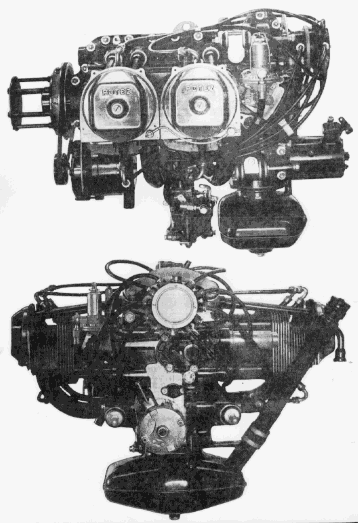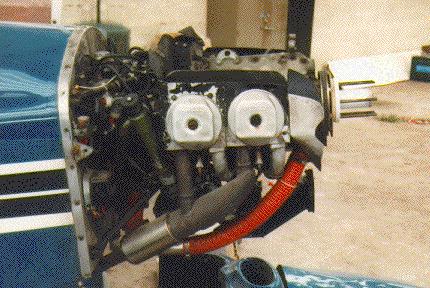
The Potez 4E20 engine
The Potez 4E20 engine came into being as a result of a design competition. The aim was to produce an engine that would be better than the popular Continental O-200 engines. The idea was to be depending less on the Americans for aircraft parts (very French feeling). The winner of the design competition would receive a sizable amount of money and at least 100 units would be produced, plus some spare parts.

|
The French Potez aircraft company entered the competition with the 4E20 engine. It was an engine not unlike the Continental, having 4 opposed cylinders and being of about the same dimensions. Unlike the Continental, which had magnetos, the 4E20 had dual coil ignition. The engine produced 105 hp, and at any rpm setting, it would produce some 10 hp more than the Continental it was competing against. The starter ring was in the wet case, sometimes scaring the **** out of maintenance people who at times found lots of metal in the oil filter. The metal was invariably grinded off the starter ring rather than being of some more delicate part of the engine. Another thing that has bothered lots of owners over the times is the fact that the oil temperature is at the redline (130 degrees Centigrade) most of the time. Most have learnt to live with that, but it can be quite scary to the uninitiated. The engine won the design competition and an initial batch of 100 units plus associated spare parts were produced. The Jodel/Robin company mounted the engine in their DR 1051, which obtained excellent performance with the engine. It seems though, that the market for such an engine was not very large, since the first 100 units were the only ones ever produced. |
That leads us to the Potez's biggest current problem: spare parts are hard to come by. The original batch of spares has long been used and it seems that people are merely fixing up parts nowadays, rather than replacing them. A US company is producing parts like cylinders and pistons, but no one has seen a new ignition part in the last two decades or so. Most Potez owners keep stock of a pile of spare parts and a lively trade among them takes place. There are some people that I know of who keep a database of who's got what and who are often called in for helping finding a part. There are also a few companies left that overhaul Potez engines. Look at the address page for more info.
The second problem with the Potez is that lots of them have been poorly maintained over the years by A&P; mechanics who did not know coil ignitions. The coil ignition, with points that have to be checked and adjusted quite frequently, differs from the usual magneto setup. The ignition should therefore be treated like the one in an old car, rather than an airplane. The Potez is notorious for bad starting due to mistreating the ignition. Treat it right and the engine will fire up at first try most of the time.
As a result of poor maintenance and a lack of good spares, lots of the Potez engines are rather worn out by now. I have received mixed reports from owners and experts. Some would not fly anything else in their Jodels, mainly because of the enhanced performance, some curse the thing up front.
Potez planned a 125 hp successor to their engine, having fuel injection. Initially, this was the engine that was planned for the DR200 series. Due to technical problems, this engine never saw the light of day.
Sometimes, things go terribly wrong. This particular Potez powered DR1051 was forced to land in a field after the engine quit. One of the owners reported:

|
"The landing in the field happened after in-flight spark plug separation. The cylinder head thread for one of the spark plugs stripped out after overtightening. Although we had a spare engine, all the heads had the same problem - presumably this is common. So we had a helicoil put in as a repair but this failed while I was flying it causing the force landing. In fact, little real damage was done and she was up again within a couple of weeks." |
Specifications, from the official engine manual
General
Power (hp) ............................ 105
@ rpm ................................. 2750
Bore (mm) ............................. 110
Stroke (mm) ............................ 90
Size (liter) ............................. 3.42
Compression .......................... 8:1
Weight, equipped (kg) ............. 105
lubricating system
Oil, T < 0 °C .................... Aero 65
0 < T < 15 °C ................... Aero 80
T > 15 °C ....................... Aero 100
Oil, amount (liter) .................. 5.50
Oil pressure, min (bar) ............ 0.7
normal (bar) ........................... 2-6
Max oil consumption (l/h)........ 0.35
Amount of consumable oil (l) .... 2.5
Max oil temp (°C) ................... 130
Fuel system
Fuel ......................... 130 AVGAS
Fuel pressure (bar) .......... 0.15-0.3

Important info for (potential) Potez owners: In France a JAR-Approved maintenance and overhaul facility exists for the Potez engine:
GMP Potez
42, rue de l'An VI
85450 Chaille Les Marais
France
Tel. (French only) 0033 251 567444
Fax: 0033 251 567909
GMP Potez is run by Charles Ollivier who has all the tooling and spares required for a full overhaul including the bottom end.
M. Ollivier has arrangements for translation of double-spaced typed/faxed enquiries received in English. Hw also has DGAC approval for three v e r y desirable modifications to the Potez, (which is generally installed on the DR 1051M1) and Piel Emeraude:
1. Installation of an oil cooler. The oil cooler is from Lycoming (AlliedSignal-Lori, Inc., 6930 N. Lakewood, Tulsa, OK 7417. Part number 8526250). Sources include Light Aero Spares Ltd (sales@lightaero.co.uk). This oil cooler has five sections (the slightly larger seven-section cooler is too large to fit). The oil cooler is fitted on the front r.h. -- as seen in the direction of flight -- firewall face and receives cool air via a cable-operated flap-valve fitted in the rear top right engine baffle). The system works very well and the days of permanent red lining the oil temp gauge in summer are now no more! Hot oil is taken from and returns cooled at the rear of the engine.
2. Starter motor. The standard Potez starter motor is a very heavy unit externally bolted to an aperture in the rear crankcase face. Apart from being heavy, the starting action thrusts a rapidly rotating pinion wheel forwards towards the oil-bathed internal starter ring, eventually causing impact damage to both, and progressively liberating steel chips which end up in the oil filter.
The Ollivier modification involves blanking off the starter motor aperture in the crank case, and the installation of a light weight starter motor and external starter ring at the front end.
3. The modification also includes removal of the very heavy old-style generator. The generator is replaced by a modern automotive alternator made by Iskra Avtoelektrika d.d. of Slovenia (IA 0507; 11.201.507; AAG1341 14V 33A). This modification requires minor changes to the aircraft electrical system.
These three mods are DGAC-approved and were instantly (!) accepted (JAR Form 1) without quibble at UK C of A renewal!
In the past, the Potez engine could be difficult to start. Putting it mildly. The combined effect of the new starter motor and alternator has transformed the start-up characteristics for the better. The aircraft is also about 10 kg lighter, but the C of G is unaltered because the lighter starter motor is moved forwards by about 80 cm. The modifications (2,3) require a very minor change in shape to the cowling air inlet lip. Only discernable by an expert!
Author Hans Teijgeler
The photos in this web site are from the excellent book by Xavier Massé,
sent in by happy Jodel owners, lifted from the web or taken by myself.